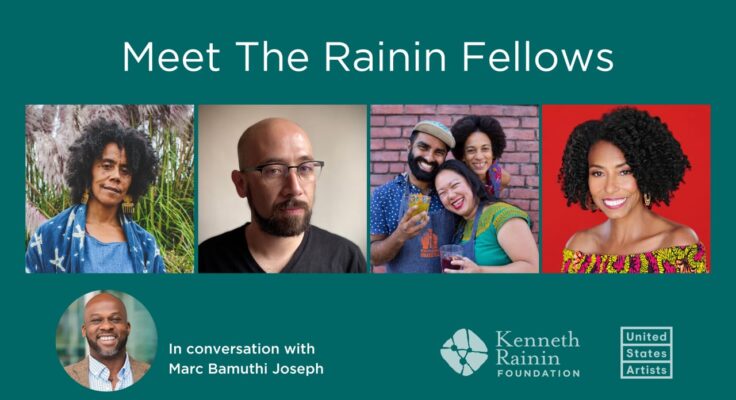On April 29, United States Artists and the Rainin Foundation hosted a virtual gathering of the inaugural Rainin Fellows: Margo Hall, Rodrigo Reyes, Amara Tabor-Smith, and Saqib Keval with Jocelyn Jackson of the People’s Kitchen Collective. The event was the culmination of years of planning and we could not resist the desire to bring these artists together to hear their perspectives on a myriad of topics.
But we wondered about the value of yet another online event. Could we get somewhere meaningful and substantive in an hour over Zoom? Would the artists’ passion and energy penetrate the tiny boxes on our screens? The answer was a resounding YES! What was our secret? We invited Marc Bamuthi Joseph, Vice President and Artistic Director of Social Impact at the Kennedy Center, to moderate the conversation. He artfully and beautifully set the tone by opening with two evocative prompts:
Where was your mother born? What’s one enduring memory or image that you have of the town where your grandmother was born?
Soulful Memories And Ancestral Stories
The artists, in turn, invited us into their worlds and recounted vivid and soulful memories that induced us to imagine their ancestral stories: Margo’s grandmother reciting poetry at church, a young Rodrigo selling avocados with his grandmother from a small table in the mountains of Michoacán, Jocelyn’s grandmother and mother escaping Money, Mississippi where Emmett Till was murdered, Saqib and his grandmother eating halwa in Malindi, Kenya, and Amara’s grandparents traveling from Rayne, Louisiana to Venice, California as part of the Great Migration.
What followed was a deeply moving and rich exploration of the artists’ perspectives on borders as contested sites, public healing, and the racial timeline that returned over and over again to central themes in their practices—profound love and collective magic.
Whose magic do you access in your art?
Whose magic do you hope to activate through your art?
“I pray to the ancestors and then I get out of the way.”
– Amara Tabor-Smith
Artists shared that their creative processes draw from the stories and experiences of their ancestors, conjuring their presence and serving as conduits. Their work recasts history from the point of view of those outside of the dominant culture.
In the context of the virologic crisis of COVID, how can artists and creative people function in service of public healing?
“Provoke a healthy discomfort—that is how we heal.”
– Rodrigo Reyes
Gathering and experiencing art in community is a tool of healing. The artistry is making people feel loved and seen in the uncomfortable space between sorrow and joy. Bamuthi invoked Isabel Wilkerson’s brilliant words from her Pulitzer Prize winning novel, The Warmth of Other Suns, in speaking about the ephemerality of ancestral histories and the tension between knowing and letting go.
How does your work address movement, movements, memory, contested sites?
“The creative space is a place for me to rest, to feel safe while at the same time navigating the burning urgency of a world on fire.”
– Jocelyn Jackson
Artists Reveal The Truth
Our long and living history of barbaric colonialism and displacement was called out, and the resulting destruction of our cultural ecosystem. The artists spoke about unpacking the accumulated grief of centuries of racial violence. It did not go unacknowledged that April 29 was the 29th anniversary of the 1992 Los Angeles uprisings. On that date, the city erupted after a jury acquitted four police officers of any wrongdoing in the arrest and brutal beating of Rodney King. And this conversation was also happening in the immediate wake of the Chauvin trial.
What recommendation would you make to the cultural landscape to utilize the political will at this moment on the racial timeline to transform the world?
“Trust the artists.”
– Rodrigo Reyes
Yes, trust artists to reveal the truth, reset the dialogue, help us heal, and show us a way forward. In the end, they pleaded with us to reclaim our humanity, sacrifice our privilege, enter unknown territory, and most importantly—NOT to reach for the master’s tools that are so familiar to us.
Do yourself a favor, watch the recording and spend an hour with these visionary Bay Area artists. It’s worth it.

